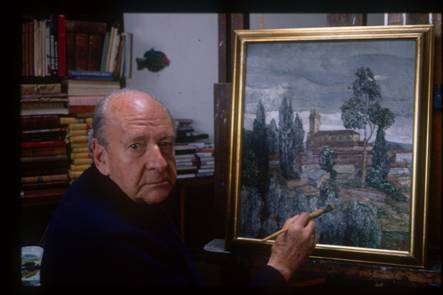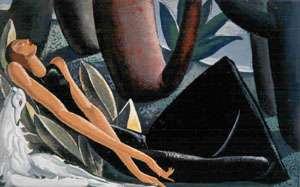Sergio Trujillo Magnenat
Sergio Trujillo Magnenat (February 21, 1911 – December 8, 1999) was a Colombian painter, illustrator and sculptor of Colombian father and Swiss mother.
Sergio Trujillo Magnenat | |
|---|---|
 Sergio Trujillo Magnenat in his Study in 1990 | |
| Born | February 21, 1911 Manzanares, Colombia |
| Died | December 8, 1999 Bogotá, Colombia |
| Nationality | Colombian |
| Known for | Painter, sculptor |
| Movement | Art Deco |
| Spouse(s) | Sara Dávila Ortiz |
Biography
At 15 years of age and took drawing classes at the night shift at the School of Fine Arts, where admitted as a regular student two years later. His teachers Roberto Pizano, Domingo Moreno Otero, Pedro A. Quijano, Francisco Antonio Cano and Coriolanus Leudo.
On his own initiative he began work on The Ballad of Viceroy Solis, his first picture book manuscript done in watercolors.
At that time, said Trujillo Magnenat, there were few museums in Colombia; and there were no galleries or exhibitions, neither art critics. Support for the artists from the government and private enterprise did not exist.
In 1932 he begins to make illustrations for the literary section of the newspaper El Tiempo and the magazine Mundo al día. He works in ceramics and photography with Carolina Cárdenas, who died a few years later and in whose honor he creates the oil painting Death and the Maiden, one of his most famous paintings and considered, altogether with Women on clubs as one of the most important works of Colombian twentieth century paintings.
Toi et moi, is his second book manuscript with illustrations in watercolors and texts in ink and gold, with marked influence from art deco movement.
He was appointed director of the Department of Decorative Arts School Fine Arts Bogotá. And as director of publications of the Ministry of National Education.
The cover of Cantique de cantiques du roi Suleiman (Song of Songs of Solomon) was made in tin embossed with inlaid ceramic, and the pages made them, just like those in Toi et moi by his own hand by calligraphic transcription of the texts, "decorating and illuminating the capital letters with details using the aesthetics characteristics of medieval manuscripts but with his own stroke of a modern painter. In addition, each manuscript contains several of his drawings that recreate scenes and feelings evoked in songs or poems."[1]
In the First Annual Hall Colombian Artists wins the silver medal with the works Pastora, Anunciación y Composición (Death and the Maiden). At the Second Annual Exhibition he won the gold medal with the oil Portrait of Mrs. Sara Dávila Ortiz, his wife.

Trujillo Magnenat, a multifaceted artist, disciplined and refined, had great humanistic education. He belongs to the generation of the pioneers of modern art in Colombia, who distinguished themselves away from the rigor of the classic rules and have achieved an art of their own. He was attentive to the international innovative spirit that the Bauhaus drove with its motto: "art and technique: a new unity". As the art curator Carmen María Jaramillo says, the mass dissemination of the work of art could be one of the fundamental objectives of Trujillo and a common denominator, both of Colombian art of the period, with its growing interest in the mural, and the tendency to recover and reassess the applied arts which allow to create art objects within reach of the common man and not just the specialized collector. This became evident since he started illustrating the main newspapers and magazines in Colombia, and illustrated books, from children's stories and booklets to history textbooks and poetry.
Without realizing it, he made art a common good, which raised the quality of life of people through murals done in public places and in factories; lithographies which adorned public schools across the country; design of furniture, lamps, tiles and toys; and the production of posters for cultural and sporting events, such as those made for the Bolivarian Games that were held in 1938, in Bogotá. In these posters, were stylized figures stand as well as a particular handling volumes and a new sense of abstraction, the precision of the artist is revealed and unfolded, so that critics and historians have recognized him as one of the most versatile in our history.
In outlining the dynamics of athletes speed of movement, he shows a fundamental characteristic and influence of Italian Futurism.
This type of works along with the covers made for the magazine America and the literary supplement for El Tiempo, in addition to his work in the Revista de las Indias and the children's magazine Rin Rin made him the pioneer of professional graphic design in the country, and perhaps the most important Colombian poster for decades.
This versatile artist draws attention thanks to his paintings of elongated figures and balanced color.
With his vigorous and prolific appearance enriched the Colombian art world and among critics has been recognized his skillful, dynamic, and precise line, making it stand out for a great artist.
For his literary and artistic training, said the writer Germán Arciniegas, Trujillo departed from the Spanish tradition and tended to go along with the French illustrators. "The sharpness of his drawings is spent by Renaissance filters and has that agility and good taste who always carry him to look in beautiful women the elegant postures and dance steps, or to recreate with a firm and tender line the strength of men and women that fight and dream, the revolts, the Quixotes of all times."
Carmen María Jaramillo emphasizes "his innovative air, its clear and consistent sense that art is a common good and a way to raise the daily life of people. Although he denies the validity of the avant-garde, his work has been completely modernist. He wants to break with tradition and propose to the aesthetics that characterized the academic art alternatives. His work is eclectic, can not be enrolled in any 'ism'. Trujillo is affirmed by the uniqueness of his work and without typecasting himself, does not remove what is seen, lived and felt in his time."[2]
In the words of art critic Germán Rubiano, "within his generation, Sergio Trujillo Magnenat is an island figure. And it is because his work is too varied to limit it to very precise objectives, and as is nationalistic in his oils and watercolors of savanna and coastal landscapes or its many illustrations of the country's history, and as it has sought to reach the people through several murals and countless drawings published in books, magazines and newspapers, also abounds in family portraits, ideals (or long remembered) figures; religious affairs and scenes of world history, particularly in his murals and illustrations."
There are other paintings with references to "tenebrismo", "claroscuro", the pointillism, the post-impressionism, symbolism, cubism, art of Ancient Egypt and especially in his work a lot of art-deco, but always with his particular stamp.
His versatility allowed him to capture landscapes and cityscapes that were either oil or watercolor, and make family and friends portraits in charcoal, pencil and ink.
Unlike the Impressionists, he used to take notes on the geographical location where he was, and later he embodied, from memory -photographic memory- the light and colors that he had seen.
He also recreated, through painting, myths and legends, and ventured into surrealism in the 70s.
Art critics have found in him an Americanism style of the type of the Mexican artist Orozco and Siqueiros. In his way, he recreated the murals of the battle of the "Pantano de Vargas" and the history of the Independence General José Hilario López.
In 1994, at the Museum of Modern Art, a retrospective exhibition of the works of Trujillo occupied three rooms: the most complete and meaningful retrospective of his work.
He died in Bogotá, Colombia, in 1999.
Personal life
Married to Sara Davila Ortiz, had six children Carolina Trujillo, Maria Cristina Trujillo, Maria Clara Trujillo, Jaime Trujillo, Sergio Trujillo, and Alberto Trujillo.
See also
References
External links
| Wikimedia Commons has media related to Sergio Trujillo Magnenat. |